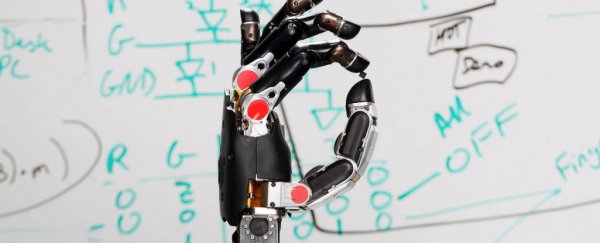The US defence force announced last week that it has given a paralysed man the ability to 'feel' physical sensations through a prosthetic robotic hand that's been directly connected to his brain. Having been paralysed for more than a decade due to a spinal cord injury, the man was able to identify when and which of his prosthetic fingers was being gently touched by an object - and all while blindfolded.
The technology points to a future where people with paralysed or missing limbs can not only get back the ability to manipulate objects and move about, but can also learn to sense which it is they're touching.
"We've completed the circuit," US Defense Advanced Research Projects Agency (DARPA) program manager Justin Sanchez said in a press statement. "Prosthetic limbs that can be controlled by thoughts are showing great promise, but without feedback from signals travelling back to the brain it can be difficult to achieve the level of control needed to perform precise movements. By wiring a sense of touch from a mechanical hand directly into the brain, this work shows the potential for seamless bio-technological restoration of near-natural function."
The DEKA Arm System - affectionately dubbed 'Luke' (as in Luke Skywalker) - was first showcased back in February, when a US army vet used the battery-powered prosthetic to scale a rock-climbing wall, using nothing but his brain power.
Now the team behind the technology has demonstrated how the battery-powered device can impart the feeling of touch on top of grip, movement, and object manipulation. They did this by placing electrode arrays onto a paralysed volunteer's sensory cortex - a region in the brain that's responsible for identifying and processing the sense of touch, which is defined by the amount of pressure that something asserts - which connected up to the prosthetic device.
Arrays were also placed on the volunteer's motor cortex, which is responsible for facilitating body movements. "The wires from the motor cortex allow the wearer to control the motion of the robot arm, and pressure sensors in the arm that connect back into the sensory cortex give the wearer the sensation that they are touching something," Mike Murphy explains at Quartz.
Loaded with highly sensitive torque sensors, the device could detect changes in pressure as they are applied to the fingers, and this was converted into electrical signals that were fed into the volunteer's brain.
When testing the arm in the lab, the researchers gently touched each of the fingers while the volunteer was blindfolded, and he reported with almost 100 percent accuracy which one was being touch, saying that it felt just like his own hand was being touched.
"At one point, instead of pressing one finger, the team decided to press two without telling him," said Sanchez. "He responded in jest asking whether somebody was trying to play a trick on him. That is when we knew that the feelings he was perceiving through the robotic hand were near-natural."
The experiment was described at the Wait, What? A Future Technology Forum, hosted by DARPA in the US last week. The team is remaining fairly tight-lipped on the finer details of the technology right now, as they're working on getting everything peer reviewed and accepted for publication in a scientific journal.
Here's what it looked like back in February:
